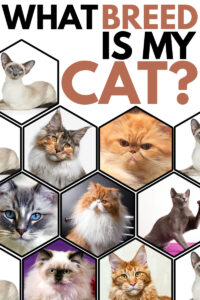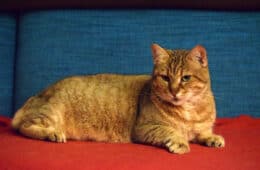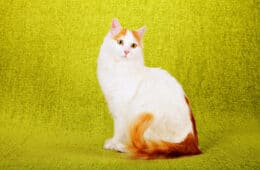Do you find yourself looking at your whiskered friend and wondering what breed it might be? Perhaps the dazzling array of colors, coat lengths, and unique body shapes catch your eye, and you can't help but question: Is my cat a purebred or a pedigreed cat?
The intrigue doesn't stop there. Your cat's unique appearance opens the door to a world of possibilities.
In this article, we will guide you through the answers to these questions. We'll explore the characteristics of different breeds, the significance of coat patterns, and how to identify your cat's specific traits.
But identifying your cat's breed isn't just about satisfying curiosity. Understanding your cat's heritage can also offer insights into its health, behavior, and care needs.
Read on, and you'll find answers, surprises, and maybe even a little touch of feline magic – without ever needing to learn complex terminology or genetics.
What Breed Is Your Cat? - The Short Answer
Is Your Cat Pedigreed? The Basic Criteria
You might be wondering if your whiskered friend is a pedigreed cat. The answer is quite simple: If your cat came without official papers, it's not a pedigreed cat.
What does that mean for your furry companion? Let's explore.
No Showtime for Non-Pedigreed Cats
Sadly, without papers, your cat can't enter the breed category in cat shows. It also shouldn't join a breeding program.
The Rare Case of a Lost Purebred
Purebred cats sometimes lose their papers. How? They might end up in a shelter and get adopted by new owners. But don't worry; this situation is rare. Ethical breeders ensure that their cats don't land in shelters.
Identifying the Unidentifiable
So, what if you suspect your cat is a purebred that lost its way? The truth is, without clear identification, like a microchip traced back to the breeder, you can't confirm your cat's pedigreed status. You might be able to guess which breed your cat resembles, but that's all it is—a guess.
Embracing Your Unique Companion
While the quest to identify your cat's breed might be thrilling, the most crucial fact remains: Your whiskered friend is unique and special, regardless of its pedigree. Embrace its individuality, enjoy its companionship, and let the mystery add a dash of excitement to your relationship. After all, sometimes, it's the unanswered questions that make life with a pet so fascinating.
What Marvelous Mixture of Features Is My Cat? A Detailed Guide
Understanding Your Cat's Unique Appearance
Is your cat purebred? Most likely not, but that doesn't mean we can't explore its unique look.
Judging features like facial proportions or body shape is best left to professionals, but coat length, color, and pattern are usually easy enough to tell.
This guide will help you describe your cat's appearance with precise and delightful terms. You'll become an expert in identifying the features that make your pet stand out!
Identifying Hair Length: Longhair or Shorthair?
The journey begins with the coat. Is your cat's hair long or short? This feature alone lets you classify your pet as a Domestic Longhair (DLH) or a Domestic Shorthair (DSH).
Exploring Patterns and Colors: The Kaleidoscope of Beauty
Next, explore the kaleidoscope of patterns and colors.
From our comprehensive list, you can pinpoint the exact shade and pattern of your cat's coat.
You could end up with terms as exquisite as "longhair red tabby and white van" or "shorthair cream and blue tortoiseshell." Quite an exciting task, right?
Need Assistance? Join the Forums!
Confused about the right terms for your cat? Feel free to post pictures of your pet on the forums, and our community will gladly help you out. Accurate and fancy descriptions await!
Celebrate Your Cat's Uniqueness
Your cat's individuality deserves celebration. Through this guide, you've not only discovered the basic classifications but also enjoyed a journey through the rich world of patterns and shades.
Your cat might not be purebred, but its unique appearance makes it no less special. So go ahead and proudly declare your cat's description; embrace its beauty and share it with the world!
But Which Breed Does My Cat Resemble?
Here are a few popular cat breeds and some of their more prominent features. Remember, this does not mean your cat is of that breed - only that you might be able to say there’s a resemblance.
Siamese Cats
Short hair, blue eyes, and a colorpoint coat pattern are the traits shared between traditional and modern Siamese cats. Modern Siamese also has uniquely svelte bodies and elongated head.
Persian Cats
A stocky build and a very long coat constitute the typical Persian look, along with large round eyes and a short nose. Modern Persian cats have flat faces, with their nose pushed back. More about Persian Cats.
Himalayan Cats
Himalayans, aka Himmies, share the build and coat length of the Persians but have a pointed color pattern. More about Himalayan Cats.
Maine Coon Cats
Exceptionally large, with long silky yet dense hair and sometimes tufts on the tips of their ears, Maine Coons can come in any color and coat pattern, except for color points. More about Maine Coon cats.
Russian Blue Cats
The bluish-gray short coat is what this breed is famous for, along with bright green eyes. There are other “blue” cat breeds such as the Korat and the Chartreux, but Russian Blues are probably better known. More about Russian Blue cats.
The common trait here? These are all breeds that have a prominent feature - be it a certain coat pattern or color, or maybe coat length - that is not very common. That does not mean it doesn't exist among non-pedigreed domestic cats.
You’ll find many “Russian Blue”, “Persian” or “Main Coon” lookalikes in shelters, all in need of a good forever home. These cats are just as beautiful and special as their purebred counterparts. Just please don’t ever breed them just because they’re beautiful!
SIGN UP FOR THECATSITE'S EMAIL UPDATES >


Want to become an expert on cat breeds? Get one of these books from Amazon. They're a great starting point:
What breed is my cat - The FAQ
Did we mention that "What breed is my cat?" is one of the most popular questions we get on the cat forums? Here are related questions that we get asked often - and the answers to them.
Is my cat a longhair or shorthair cat?
When you find yourself wondering, "Which breed is my cat most like?", the first thing that you need to determine is whether your cat has long or short hair. This will help you narrow down the breeds that your cat could potentially be.
While this seems like it would be a simple question to answer, many cat owners are unsure as to whether their cat is long-haired or short-haired. There is actually no formal definition for what constitutes "long" in a cat's coat.
Some breeds are clearly long-haired though. Persians are probably the most well-known breed that clearly has a long-haired coat.
Ragdolls are also considered long-haired.
Even Maine Coons are counted among the longhaired breeds.
And of course, your cat may be a domestic longhair—of no particular breed.
Genetically speaking, only cats that have two copies of the recessive longhair gene will be longhaired cats. A cat that has one copy of the longhair gene and one of the shorthair gene will be shorthaired but still, carry the longhair gene.
Sometimes, a cat has neither a very long nor short coat, as their hair length falls somewhere in the middle.
Some cats are simply medium-haired! They tend to have a thick, bushy undercoat and silky hair, with a long, flowing tail.
Some medium-haired cats also have a longhaired "mane" of hair on their chests. Because a cat must have two copies of the longhair gene to display any form of long coat, these cats are in fact considered part of the longhaired group and they are often known as "semi-longhaired".
Could my shelter cat be a purebred cat?
While purebred shelter cats are rare, they are not unheard of!
There are a few different reasons that a purebred cat could end up in an animal shelter.
Sometimes, a person purchases a purebred cat from a breeder because they like the look of a cat, but they are unaware of the unique needs, personality traits, and behaviors of that specific breed.
They may discover that the cat is not a good fit for their home and take the cat to a shelter.
Other times, backyard breeding facilities—aka kitten mills—are shut down by animal control authorities due to unfit conditions for cats.
Purebred cats and kittens are often taken to shelters. There have also been situations in which cat breeders go through personal trauma (such as a death in the family), have to shut down their business, and give their cats to a shelter.
Last but not least, a purebred cat can get lost and end up in a shelter. These things do happen.
I found a stray cat - can it be a purebred Maine Coon/Siamese/Persian?
It's possible that your stray furry friend is purebred. Like all cats, purebred cats can run away from home, get lost, or otherwise find themselves living outside of a home.
Just like with shelter cats, it's impossible to tell for sure whether your stray is purebred without a DNA test.
If you decide to take in a stray cat, your vet may be able to give you an idea of what breed of cat he or she may be. And of course, you can always ask for our members' opinions here.
Regardless of whether or not you care about the breed of your newly found friend, it's important to take him or her to the vet to check for and treat the many health issues that cats can encounter when they are living outdoors.
How can I tell if a cat for sale is really purebred or not?
If it's important to you that the cat you purchase is purebred, you must purchase your cat through a registered breeder. This will ensure your cat's history and living conditions are up to par.
Registered breeders are also more likely to sell kittens that are neutered/spayed, microchipped, treated for parasites, and have received their first round of vaccinations.
The breeder should provide you with registration paperwork so that you can register your kitten with an official purebred cat organization.
This registration paperwork is often referred to as a "blue slip." You'll also need to submit the cat's pedigree, which will state the names and breeds of the cat's parents, as well as indicate whether or not the cat was sold to be bred.
If you plan on registering your cat so that you can show him or her, it's important that you keep track of every single piece of paperwork involved in the sale—everything from bills to vet records to credit card slips!
My cat mated with a purebred cat - will the kittens look like the father or the mother?
It can be very difficult to predict what the kittens will look like. Guessing the colors and coat patterns may be possible - but that's not necessarily related to the breed of either parent.
The answer to the coat color question depends—among other things—on the sex of the kitten! Male and female kittens' patterns and colors are inherited differently.
Can my cat undergo genetic testing to see which breed she is?
When you're asking yourself, "What breed is my cat?" the next natural question to ask is whether there is a scientific test that can prove your cat's ancestry.
The answer is yes! A variety of companies provide mail-out cat DNA testing which can tell you what breed(s) make up your cat's pedigree. It's easy to take a DNA sample from your cat.
You simply swab the inside of their cheek or cut a small piece of fur (per the DNA test kit's instructions), mail it to the company, and wait for the results! Some reputable companies that provide DNA testing for cats include UC Davis Veterinary Medicine and Base Paws.
Want to show us your cat and see what other members think? Don't leave a comment here asking about your cat.
Instead, post a thread in our special forum titled Describing Cats - What Does My Cat Look Like? Add a photo or two and wait for replies.
SIGN UP FOR THECATSITE'S EMAIL UPDATES >
Save and share this article! Here's a Pinterest pin you can use for doing just that -

Comments? Leave them using the form below. Questions? Please use the cat forums for those!
Note: We may get commissions for purchases made through links on this page.




202 comments on “What Breed Is Your Cat? Here’s How To Tell!”